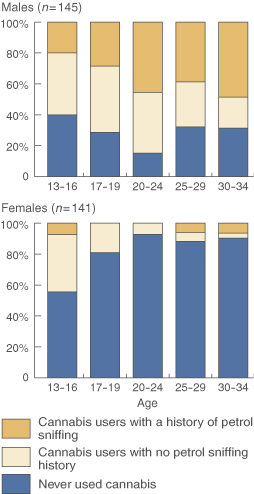To the Editor: We write to alert policy makers and clinicians to the challenge presented by rising cannabis use in north-east Arnhem Land, in the Northern Territory, given that many current cannabis users were previously petrol sniffers. In the past five years, there has been a rise in cannabis use and evidence of expansion of supply links in the Miwatj region.1 There are concerns that rising cannabis use is associated with social effects: increased family violence, drug–alcohol psychosis, self-harm and suicide, and community disruption. Policy makers seeking to foster initiatives to minimise harmful outcomes must develop general policies that can have local effects in a varied Northern Territory population. NT police have targeted cannabis in remote communities. A Substance Abuse Select Committee and Illicit Drugs Task Force, each with Indigenous representation, will report to the NT government during 2002.
We recently began collecting baseline data to allow us to evaluate the effects on patterns of use of cannabis (and related harm) of community-wide interventions. These interventions will be similar to those implemented for petrol sniffing,2 but with a focus on improved availability of appropriate drug education. We have selected a random sample of about a third of the residents (aged 13–34 years) from two communities. From this sample, current cannabis users (at least weekly) and past petrol sniffers have been identified by using health worker consensus classification, supported by data from review of the health clinic chart and self-report, if available. These data for 145 males and 141 females are presented in the Figure. Among males aged 20–34 years, 74% are current cannabis users and, of these, 60% are former petrol sniffers. To date, 57 cannabis users have agreed to interview (34 males and 23 females) and, of these, 38 met DSM-IV criteria for cannabis dependence.3
A particular health concern is that persistent cannabis use may compound any residual cognitive impairment from petrol sniffing.
- 1. Clough AR, Guyula T, Yunupingu M, Burns CB. Diversity of substance use in eastern Arnhem Land (Australia): patterns and recent changes. Drug Alcohol Rev. In press, 2002.
- 2. Burns CB, Currie BJ, Clough A, Wuridjal R. Evaluation of strategies used by a remote Aboriginal community to eliminate petrol sniffing. Med J Aust 1995; 163: 82-86.
- 3. American Psychiatric Association. Diagnostic and statistical manual of mental disorders. 4th ed. Washington, DC: American Psychiatric Press, 1994.






This research is funded by the National Health and Medical Research Council through support from the National Illicit Drugs Strategy and the Commonwealth Department of Health and Ageing. The study has ethical approval from the Human Research Ethics Committee of the NT Department of Health and Community Services and the Menzies School of Health Research.
None identified.